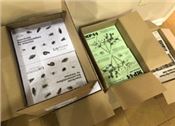|
Start The 2020 Growing Season Right With Latest Editions Of Division Of Ag Weed, Pest, Disease Management Publications

MP44, Recommended Chemicals for Weed and Brush Control, MP144, Insecticide Recommendations for Arkansas and MP154, the
Arkansas Plant Disease Control Products Guide, have all been updated for the new year, and are available at no cost.
They are also available at any of extension’s winter production meetings, which will be taking place throughout January and February
LITTLE ROCK, ARK.
The 2020 versions of the University of Arkansas System Division of Agriculture publications on managing insects, weeds and plant diseases are now available online, through Cooperative Extension Service offices across the state, and, in one case, as a mobile-friendly website.
The publications, which spell out up-to-date recommendations for managing pests, weeds and diseases in row crop agriculture, as well as fruit, vegetable and garden production and more, are available at no cost. In addition to their availability at CES offices in all 75 counties throughout the state, they are also typically available at winter production meetings and demonstrations organized by the Cooperative Extension Service.
Tom Barber, extension weed scientist for the Division of Agriculture, said more than 11,000 copies of the MP44, “Recommended Chemicals for Weed and Brush Control,” were ordered this year.
“All MP publications are based on data, the best non-biased sources of research data available and are just as relevant today as they were 60 years ago,” Barber said. “It is important for agriculture clientele to have up-to-date non-biased recommendations to remain profitable, regardless of which sector of agriculture they are in.”
“MP” stands for “miscellaneous publication.” The earliest version of the MP44 on file with the Cooperative Extension Service dates back to 1961.
The MP144, “Insecticide Recommendations for Arkansas,” is the most-requested entomology-related publication within the Cooperative Extension Service, said Glenn Studebaker, extension entomologist for the Division of Agriculture.
“It has recommendations on insecticides for row crops, fruits, vegetables as well as animal and household pests,” Studebaker said. “It is also a source of information on economic treatment thresholds, insecticide toxicity, re-entry and pre-harvest intervals.”
Travis Faske, extension plant pathologist for the Division of Agriculture, said the MP154 is an invaluable resource for selecting commercially available fungicides and nematicides for not only row crops, fruits and vegetables, but ornamental flowers as well.
“Information used in the publication is generated by Extension plant pathologists that conduct applied research trials across the state,” Faske said. “The 2020 guide has been reformatted to group the row crops, whereas in the past it was organized alphabetically.”
In 2019, the Division of Agriculture released a mobile-friendly version of the MP-144, which is searchable through a web browser (such as Firefox or Google Chrome) on mobile devices such as smartphones and tablets (learn more about the mobile-friendly database at http://bit.ly/2XhtoEj). While the mobile-friendly version currently covers only recommendations for row crops, Studebaker said he plans to eventually add recommendation data for fruit and vegetable production.
A PDF of the MP-144 can be downloaded at https://www.uaex.edu/publications/mp-144.aspx . The MP-44 can be downloaded at https://www.uaex.edu/publications/MP-44.aspx. MP154 can be found at https://www.uaex.edu/publications/mp-154.aspx . ∆
|
|